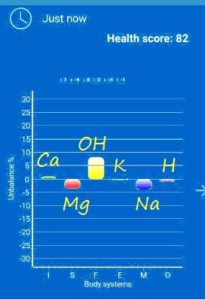Parkinson’s disease (PD) is the second most common neurodegenerative disease in the world. Its causes are poorly understood and there is no proven therapeutic strategy for slowing disease progression. The core motor symptoms of PD are caused by the death of dopaminergic neurons in the substantia nigra pars compacta (SNc).
On the base of pulse spectral analysis, we propose the hypothesis of the mechanics of this disease. The hypothesis is based also on the theory of Dr. Samokhotsky, who postulated that the balance of essential 4 minerals (calcium, potassium, magnesium and sodium) is a necessary and sufficient condition for normal metabolic processes (https://repo.odmu.edu.ua/xmlui/handle/123456789/3284?show=full&locale-attribute=en ).
Here is the screen of the mobile app to calculate the dynamic balance of minerals via pulse. The reading of the patient with Parkinson’s disease is here represented.

Here we can see Mg++, Na+ and OH- excess. The important role of Na+ channels in metabolism is discussed here
https://www.ncbi.nlm.nih.gov/pmc/articles/PMC2230911/ [1]
Let’s check this hypothesis. This work describes the tremendous role of Na+ in motor action. It is obvious that Parkinson’s disease is a disturbance exactly this function. The article also shows the role of the following fact that influence at the Na+ channels:
– “fast inactivation can be disrupted by internal proteases”.
But exactly the excess of OH- radical is represented in the pulse diagnosis readings above in the text. It gives the right to explain the definite aspect of the disease – the increased alkalinity of the intracellular medium is one of the causes of disease. The period of action of Na+ inside the cell is predefined and If Na+ is not deactivated in proper time – the locomotion process is violated and manifested in all visible symptoms of Parkinson’s disease. If we accept this position regarding the role of OH- radical, the following question arises – can we improve the function of fast inactivation of Na+ channels with the help of one of the other minerals of Dr, Samokhotsky?
The following article allows making a positive conclusion:
https://www.ncbi.nlm.nih.gov/pmc/articles/PMC3020095/ [2]
The information regarding the inhibitor’s functions of fast sodium channels is discussed there and the mechanics of action is suggested. On the base of this article [2] it is possible to conclude that Ca++ deficiency increases the risk of cell’s apoptosis due to the regulation dysfunctions of the fast Na+ channels. Please note – the apoptosis is the process that actively is going at Parkinson’s disease patients. The Ca++ deficiency increases the movement of Na+ into the cell and even at a low concentration of Ca++, the cell gets excess of intracellular Ca++ in comparison with the situation at the health condition.
Traditional L-Dopa administration for the treatment of Parkinson’s patients seems rather short-sighted method. It influences the prolactin concentration. A low level of prolactin hormone leads to an inability to absorb Ca++. The reduction of metabolically active Ca++ ions under the action of L-Dopa partially decreases Parkinson’s disease symptoms, but many other functions of Ca++ are disturbed (osteoporosis, memory loss. muscle spasms. numbness and tingling in the hands, feet, and face, depression, hallucinations, etc.), and during the time the situation becomes always harder.
Thus, it is obvious that careful attention should be paid to other mechanisms of Ca++ metabolism regulation and in the light of pulse diagnosis readings, we suggest it is required to reduce the level of Na+ and elevate the concentration of Ca++. Taking into account close interrelation of Ca++ influx into a cell with Na+ it is proposed to elevate Ca++ concentration at the background of simultaneous inhibition of fast Na+ channels with proper amino acids. For example, a possible natural inhibitor is substances on the base of glutamine (N-methyl-D-glutamine (NMDG) [2]. And these suggestions receive confirmation in the following article:

Leave a Reply